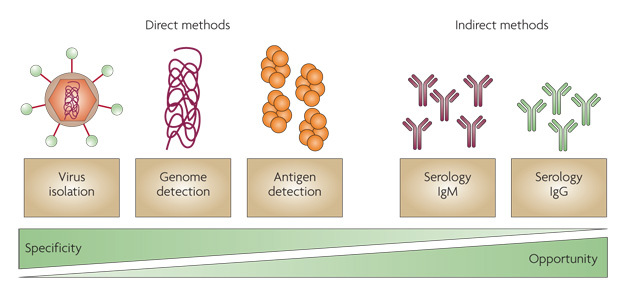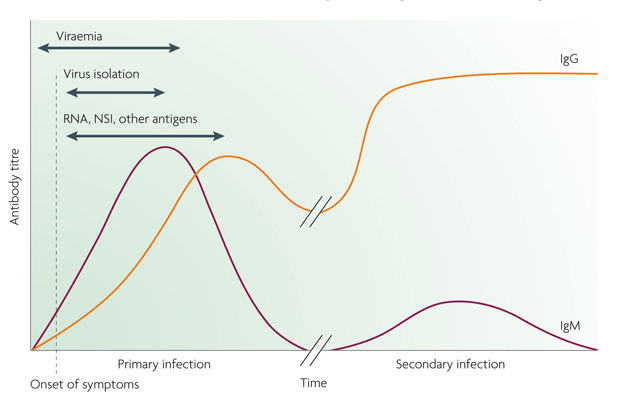« Prev Next »

Current Dengue Fever Research
Introduction
Basic Research on Dengue
What does basic dengue research involve? Basic research includes a wide range of studies focused on learning how the dengue virus is transmitted and how it infects cells and causes disease. This type of research investigates many aspects of dengue viral biology, including exploration of the interactions between the virus and humans and studies of how the dengue virus replicates itself.
One important field of basic research is dengue pathogenesis, the study of the process and mechanisms of dengue in humans. Scientists want to understand how the dengue virus causes damage to the human body and how the immune system responds to a dengue infection so that they can develop new treatments for the disease. For example, researchers want to understand why bleeding and vascular leakage occur in patients with severe dengue illnesses. Knowledge of the disease pathway may help doctors and clinicians diagnose dengue at earlier stages. Researchers want to find out whether there are genetic factors that result in an increased or decreased risk of infection for individuals. Some people may be genetically susceptible to develop more severe symptoms than other people.
Scientists are also studying the dengue viruses to understand which factors are responsible for transmitting the virus to humans. Researchers are investigating how the dengue virus replicates itself and the structure of the viral components, such as the capsid, membrane, and envelope proteins. Scientists also want to know — how do the dengue viruses manage to avoid detection by the immune system? Because viruses can evolve and gain mutations over time, researchers are examining dengue viral genetics and evolution to investigate changes in viral genomes over time. These variations may help the virus hide from the immune system. Scientists know that particular viral sequences are associated with more severe dengue symptoms. In addition, certain dengue sequence variations may produce more deadly viruses with a greater potential for causing epidemics. This kind of information can help scientists monitor the regional spread of particularly dangerous dengue strains to help communities prevent or prepare for dengue outbreaks.
Other dengue research focuses on vector biology. What is vector biology? This field of dengue research studies the disease vector, Aedes mosquitoes. Vector biology studies mosquito ecology, population biology, genetics, and behaviors to understand how mosquitoes transmit the dengue viruses. Researchers can also study dengue transmission patterns. As one example, researchers studied dengue infections in children living in Nicaragua and saw that patterns of dengue transmission depended on changes in climate and changes in the dengue serotypes in the area. Large-scale studies of patterns in dengue transmission can provide essential information to resist the disease, identify and diagnose dengue cases, and implement mosquito-control efforts.
Diagnostics
Patients with severe dengue illnesses can be treated successfully if they are diagnosed as early as possible. Scientists are working on improving dengue diagnostics so that patients infected with dengue can be treated quickly. What would the ideal diagnostic test for dengue do? The ideal diagnostic test would be able to distinguish dengue from other diseases with similar symptoms and distinguish one dengue serotype from another. An ideal diagnostic test would be highly sensitive during the acute stage of the infection, quick and easy to use, and affordable.
How is dengue diagnosed? A number of laboratory methods are used to diagnose dengue, including detection of the dengue virus, viral RNA, viral antigens, and antibodies against the virus in the patient's blood or tissues (Figure 1). The virus can be detected in the blood for only four to five days after the onset of symptoms. During this early stage of the disease, isolation of the virus, viral RNA, and viral protein can be used to diagnose dengue.

The detection of antibodies (IgM and IgG) in the blood of an infected individual is an indirect method to diagnose dengue. This method is commonly used to diagnose dengue in the later stage of the disease, after the viral levels have decreased. Antibodies against dengue can be detected in most patients five days after the onset of symptoms, and IgG can be detected for many months and even years after an infection (Figure 2). During a primary (first) dengue infection, IgM levels are very high, but during a secondary infection, IgM levels are lower. The levels of IgG actually increase during a secondary infection. Therefore, clinicians can measure the amounts of IgM and IgG to decide whether a patient has a primary or a secondary dengue infection. This test can be useful because patients with secondary infections are more likely to have severe dengue than those who have not had a previous infection. Because dengue can be mistaken for other diseases such as yellow fever, measles, and influenza, it is best to confirm a diagnosis of dengue by detecting the antibody response and testing for direct evidence of the virus.

Have researchers developed any new diagnostic tests to diagnose dengue? Recently, scientists developed a rapid, one-step test to detect and distinguish all four dengue serotypes. This test is based on reverse transcription polymerase chain reaction amplification of the viral RNA, and it is a sensitive, rapid, and cost-effective tool to diagnose patients with dengue. A second approach involves diagnosing dengue infections by detecting NS1, one of the seven nonstructural dengue proteins. NS1 is produced in large quantities during dengue viral replication, and it can be detected as early as the first day the patient experiences a fever.
Is there a way to know which patients might develop severe dengue? Scientists want to find ways to quickly identify patients who are the most likely to develop severe dengue illnesses. To identify these patients, researchers must first discover predictive factors for severe dengue. One way researchers can discover these factors is to monitor the progression of the disease and look for factors that predict severe illness by taking frequent blood samples and ultrasound images from patients with dengue. Ultrasound can measure indicators of severe dengue, including the thickening of the gall bladder wall and excess fluids around the tissues and organs in the abdomen and chest cavity. Knowledge of additional predictive factors could help researchers design more effective diagnostic tests. Another strategy involves applying decision-making computer models to diagnose patients with dengue and predict their prognoses by using clinical data, such as the patient's platelet count and the presence of preexisting IgG antibodies against dengue in the blood.
Dengue Surveillance
What can other fields of research do to prevent and control dengue? In addition to performing basic research and improving diagnostics, improving dengue surveillance is an essential way to prevent and control dengue transmission. The World Health Organization — in partnership with ministries of health, research centers, and laboratories around the world — has developed a dengue surveillance system called DengueNet, a database that can be continuously updated to share current and historical data on dengue cases. The goals of DengueNet are to standardize reporting of dengue cases and to improve the preparedness of public health officials by providing early warnings prior to epidemics, which can help reduce fatality rates.
Monitoring mosquito populations is a first line of defense against dengue. Vector surveillance allows for a prompt response to control mosquito populations and limit dengue transmission. Studying vector competence, the ability of Aedes mosquitoes to acquire and transmit the dengue virus, can provide important information about variations in the transmission of the different dengue serotypes. Researchers have shown that delayed mosquito-control responses can lead to an exponential increase in both the number of infected people and health costs. Public health officials can prevent large dengue outbreaks by using surveillance information to plan mosquito-control efforts and interventions and to provide resources to affected areas. Vector surveillance is crucial for public health officials so that they can provide a prompt and preventative response to dengue.
Summary
References
Balmaseda, A. et al. Trends in patterns of dengue transmission over 4 years in a pediatric cohort study in Nicaragua. Journal of Infectious Diseases 201, 5–14 (2010). doi:10.1086/648592
Deubel, V. "The Contribution of Molecular Techniques to the Diagnosis of Dengue Infections." In Dengue and Dengue Hemorrhagic Fever, eds. D. J. Gubler & G. Kuno (Cambridge: CABI, 2001): 335–365.
Guzman, M. G. et al. Dengue: A continuing global threat. Nature Reviews Microbiology 8, S7–S16 (2010). doi:10.1038/nrmicro2460
National Institute of Allergy and Infectious Diseases. "NIAID's Role in Dengue Fever Research" (2011).
———. "Predicting Who Will Get Sickest from Dengue Virus" (2009).
Peeling, R. W. et al. Evaluation of diagnostic tests: Dengue. Nature Reviews Microbiology 8, S30–S37 (2010). doi:10.1038/nrmicro2459
Priyadarshini, S. Single test to detect all dengue serotypes. Nature India (2008). doi:10.1038/nindia.2008.109
Saxena, P. et al. Development and evaluation of one step single tube multiplex RT-PCR for rapid detection and typing of dengue viruses. Virology Journal 5, 20 (2008). doi:10.1186/1743-422X-5-20
Simmons, C. P. et al. "Understanding Pathogenesis, Immune Response and Viral Factors." In Report of the Scientific Working Group Meeting on Dengue, Geneva, 1–5 October, 2006. Geneva: World Health Organization, 2007: 54–60.
Tanner, L. et al. Decision tree algorithms predict the diagnosis and outcome of dengue fever in the early phase of illness. PLoS Neglected Tropical Diseases 2, e196 (2008). doi:10.1371/journal.pntd.0000196
Vazquez-Prokopec, G. M. et al. Quantifying the spatial dimension of dengue virus epidemic spread within a tropical urban environment. PLoS Neglected Tropical Diseases 4, e920 (2010). doi:10.1371/journal.pntd.0000920
Vazquez-Prokopec, G. M. et al. Unforeseen costs of cutting mosquito surveillance budgets. PLoS Neglected Tropical Diseases 4, e858 (2010). doi:10.1371/journal.pntd.0000858
Vorndam, V. & Kuno, G. "Laboratory Diagnosis of Dengue Virus Infections." In Dengue and Dengue Hemorrhagic Fever, eds. D. J. Gubler & G. Kuno (Cambridge: CABI, 2001): 313–333.
World Health Organization. Dengue: Guidelines for Diagnosis, Treatment, Prevention and Control. Geneva: World Health Organization and the Special Programme for Research and Training in Tropical Diseases, 2009.
———. "DengueNet Database and Geographic Information System." (2011).





















